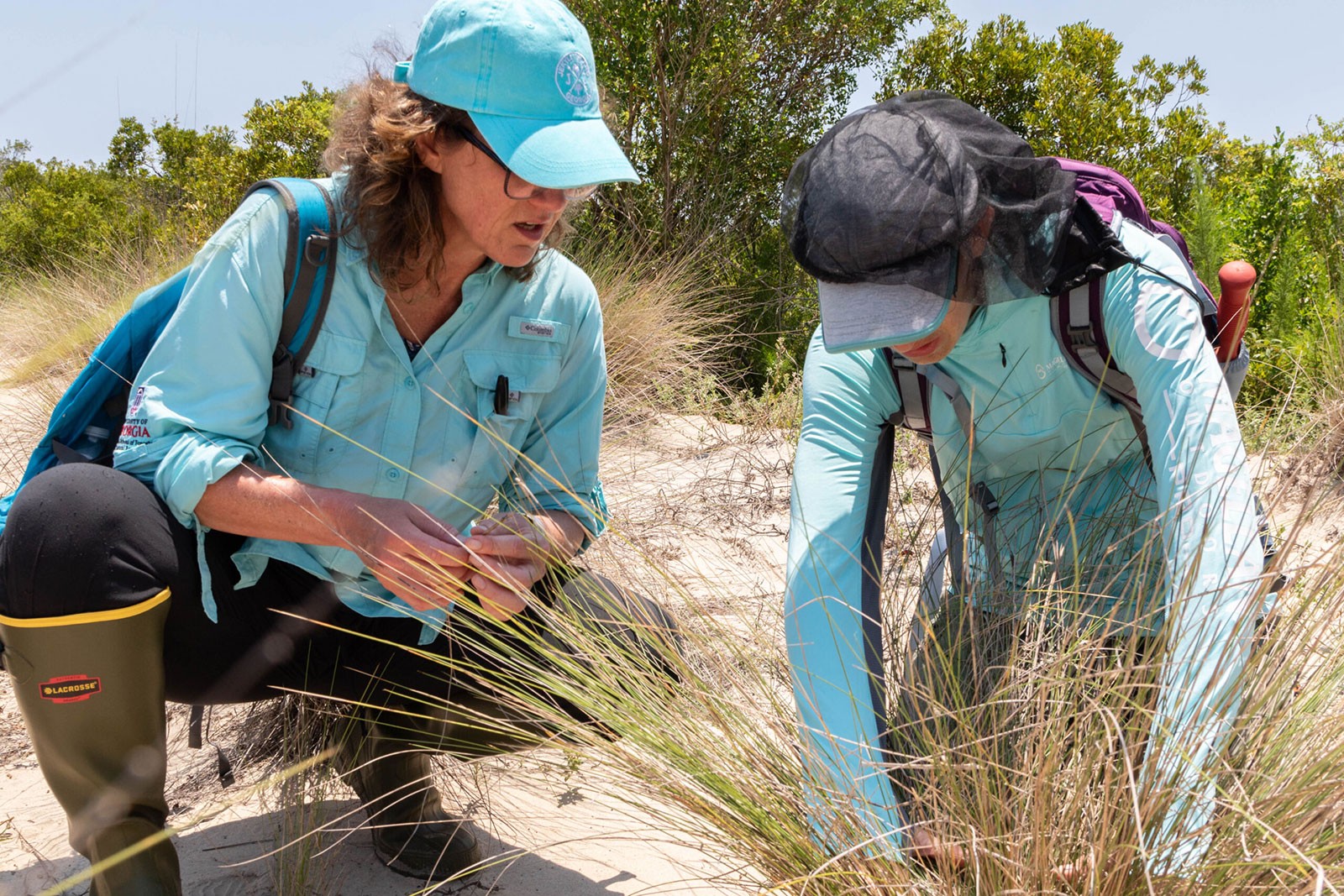On Little St. Simons Island, Elizabeth King, an associate professor at the University of Georgia, stands in a knee-high meadow of sweetgrass, accompanied by Sara Meissner, a Ph.D. student at UGA. They brave the bugs, snakes, and a scorching summer heat wave to conduct research as part of a collaborative study with 20 academics, land stewards and coastal community members. Their shared mission: to monitor, restore and conserve the native sweetgrass populations along the Georgia coast through a project funded by UGA Marine Extension and Georgia Sea Grant.
Sweetgrass, known scientifically as Muhlenbergia sericea, thrives in inhospitable environments left behind by flattened dunes. From North Carolina to Florida, sweetgrass habitats support communities — ecological and human alike. The plant plays a vital role in erosion control and moisture retention, creating an ideal habitat for other plants, insects and small mammals. For the Gullah Geechee people, sweetgrass basket-weaving represents not only a cultural heritage deeply rooted in their African ancestry but also a source of income.
However, the future of sweetgrass is threatened. Found on barrier islands just behind dune systems, these delicate ecosystems are shrinking due to coastal development, rising sea levels and erosion. King, who holds a joint appointment at UGA’s Odum School of Ecology and Warnell School of Forestry and Natural Resources, is leading the project. She explains that these threats, coupled with the encroachment of other plant species, make it difficult for sweetgrass to thrive.
“Sweetgrass is between a rock and a hard place, or, really, between shrubs and a wet place,” said King.
The UGA research team’s objectives are three-fold: mapping existing sweetgrass habitats on the coast, studying different management and restoration strategies at sites such as Jekyll and Little St. Simons islands, and collaborating with the Gullah Geechee community to create outreach materials focused on culturally significant plants in coastal Georgia.
“The more we learn about this ecologically and culturally important species, the better chance we have at improving preservation and restoration efforts,” said Mark Risse, Director of UGA Marine Extension and Georgia Sea Grant. “We are excited to support King’s efforts to further scientific understanding and enhance community engagement as a way to address economic and environmental issues.”
Some of the largest populations of sweetgrass on the Georgia coast exist on Little St. Simons Island. Managers there have experimented with prescribed burns and mowing to suppress the growth of other plants encroaching on the sweetgrass meadows. King and Meissner are studying the effectiveness of different management strategies and seeking ways to enhance them further. Their goal is to develop best practices for sweetgrass management that can be shared with other islands in Georgia and the Lowcountry region where sweetgrass grows.
Studying sweetgrass meadows comes with challenges. “There’s tremendous variability, even on this small island. There are so many moving pieces,” said Meissner. Factors such as soil moisture, nutrients, groundwater depth, and minor variations in elevation can impact the outcomes of various management techniques.
Their research is working to pinpoint these parameters. In addition to collecting scientific data, they are also documenting the historical management of sweetgrass on the island. “Changes take years or decades to unfold, so learning from people’s knowledge and past experiences is an invaluable source of information,” said King.
Farther south, Joseph Colbert, wildlife biologist at Jekyll Island Authority and one of the collaborators on the project, is focused on restoring sweetgrass habitat on Jekyll Island. Unlike Little St. Simons, Jekyll Island’s sweetgrass meadows are scarce.
“We can’t count on the sweetgrass plots we have left to remain or expand,” said Colbert.
With help from Georgia Audubon, another partner on the project, the team planted 30,000 sweetgrass plugs, transforming acres of unused grass lawn into a diverse native landscape dominated by sweetgrass. Once established, the revitalized habitat will stabilize soils, enhance the island’s resilience to flooding and storm surge, and provide food and shelter for various animals.
Looking ahead, Colbert envisions opening Jekyll’s restoration sites to the Gullah Geechee community, welcoming them to harvest sweetgrass for basket-weaving. In the meantime, the team will collect monitoring data to include in the Sweetgrass Restoration and Management Guide being developed as part of the project.
In addition to research and restoration efforts, preserving sweetgrass populations for future generations requires community engagement. Collaborators, Mya Timmons and Kay’La Brennon, members of the Harris Neck Gullah Geechee community, are working to create innovative outreach resources for the project. They have been interviewing people in their community to create a Culturally Important Plants Identification Guide, drawing on cultural historical knowledge.
“We’re helping preserve Gullah Geechee history that may have been lost otherwise,” said Brennon.
In addition to the plant guide, Timmons, a talented illustrator, is creating a coloring book that not only showcases the beauty of coastal plants but also includes educational information. The aim is to inspire younger generations to appreciate the cultural significance of these plants. “It’s a fun way to get younger generations interested and involved,” said Timmons.
The team is already spreading the word about the project at Gullah Geechee community events, including the grand opening of the Gullah Geechee Heritage Corridor office in Beaufort, S.C. They also have plans to bring students from the Carver Heights neighborhood in Savannah to Harris Neck National Wildlife Refuge to learn about Gullah Geechee uses of plants growing there.
As the threats facing sweetgrass persist, the collaborative efforts led by UGA bring hope for the preservation of the plant, from its ecosystem-supporting roots to its basket-forming stems. Through research and community partnerships, King and her multidisciplinary team of researchers, conservationists, and local leaders strive to ensure that the legacy of sweetgrass endures, safeguarding both nature’s delicate balance and the traditions of the Gullah Geechee people.

